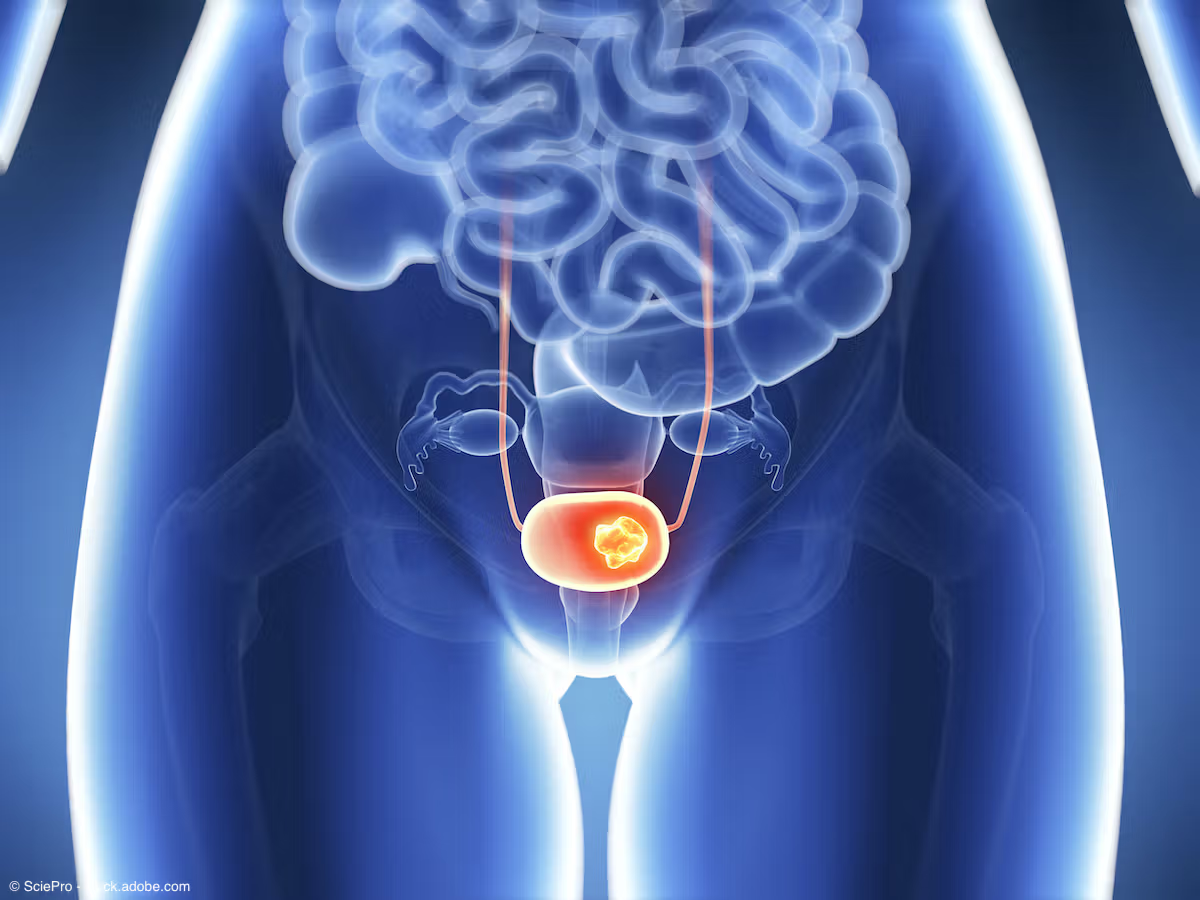News
Article
Neoadjuvant APL-1202 plus tislelizumab is safe in patients with MIBC
Author(s):
Key Takeaways
- The combination of APL-1202 and tislelizumab showed a higher pCR rate than tislelizumab alone, especially in PD-L1 low tumors.
- Retrospective analysis identified a large subset of patients with < cT2 disease, complicating efficacy evaluation.
The pCR rate was 33% with APL-1202 plus tislelizumab compared with 26% with tislelizumab alone.
Final results from the phase 2 ANTICIPATE trial (NCT04813107) of neoadjuvant oral APL-1202 (nitroxoline) plus tislelizumab-jsgr (Tevimbra) vs tislelizumab alone showed that the combination is safe in patients with muscle-invasive bladder cancer (MIBC) who were ineligible for or refused cisplatin-based chemotherapy.1,2
A phase 3 trial is assessing APL-1202 as a monotherapy for patients with intermediate-risk NMIBC.

The data, presented at the 2025 American Society of Clinical Oncology Genitourinary (ASCO GU) Cancers Symposium in San Francisco, California, also showed that the combination demonstrated a positive trend toward higher activity in patients with PD-L1 “low” tumors. However, according to the authors, “Evaluation of the efficacy in MIBC is complicated by the large subset of patients enrolled retrospectively determined to have < cT2 disease.”
Previous interim results from the phase 2 study were presented at the 2024 ASCO GU Symposium, showing promising pathological complete response (pCR) rates and data that met the prespecified thresholds for study expansion.3 The updated data report on the final primary end point analysis.
In total, the trial enrolled 103 patients with cT2-T4aNOMO MIBC. Of these, 28 patients declined radical cystectomy following neoadjuvant treatment, which included 16 patients in the combination arm and 12 patients in the monotherapy arm. Thus, the efficacy analysis included 75 patients, of whom 43 received the combination and 32 received tislelizumab monotherapy.
Patients received neoadjuvant tislelizumab Q3 weeks for 3 cycles with or without APL-1202 orally TID. Radical cystectomy was completed following therapy in 42 of 43 patients in the combination arm and 31 of 32 patients in the monotherapy arm. The primary end point was pCR (pT0N0) rate, and secondary end points included central pathologic response (PaR; < ypT2N0) rate and safety.
Overall, the pCR rate (pT0N0) was 33% (12/43) among patients who received APL-1202 plus tislelizumab compared with 26% (7/32) among patients who received tislelizumab monotherapy.
The authors added, “On retrospective central pathology review of baselineTURBT specimens, a large subset of patients were determined to be ineligible due to < c2 disease (33/75).”
Thus, the authors conducted an exploratory analysis of the subset of patients who were retrospectively defined as ‘protocol eligible.’ In these patients, the pCR rate was 41% (9/22) among those who received APL-1202 plus tislelizumab compared with 20% (4/20) among those who received tislelizumab monotherapy.
Stratified by PD-L1 status, the combination demonstrated a numerically higher pCR in those with PD-L1 high and PD-L1 low tumors. Specifically, among those with PD-L1 high tumors, the pCR rate was 28% (5/18) with the combination compared with 25% (4/16) with tislelizumab alone. Among those with PD-L1 tumors, the pCR was 28% (7/25) with the combination vs 19% (3/16) with tislelizumab alone.
Regarding the study’s secondary end point, the central PaR rate among all evaluable patients was 44% (19/43) in the combination arm vs 41% (13/32) in the monotherapy arm. By PD-L1 status, the PaR rate in PD-L1 high tumors was 39% (7/18) with APL-1202 plus tislelizumab compared with 50% (8/16) with tislelizumab alone. Among patients with PD-L1 low tumors, the PaR rate was 48% (12/25) in the combination arm vs 31% (5/16) in the monotherapy arm.
Overall, treatment-related adverse events (TRAEs) were reported in 59% (35) of patients who received APL-1202 plus tislelizumab vs 44% (19) of patients who received tislelizumab alone. The majority of TRAEs (94%) were CTCAE grade 2 or lower.
The authors note several limitations in their findings. As mentioned previously, there were a considerable number of patients determined to have < cT2 disease on retrospective analysis.
They also noted “Evaluation of efficacy is further complicated by a large subset of patients declining [radical cystectomy] after neoadjuvant treatment, underlining the need for novel bladder-sparing approaches.”
However, they wrote, “A signal of higher activity of [APL-1202 plus tislelizumab] may be present in PD-L1 "low" tumors, supporting further exploration of the immunomodulatory effects of [the combination].”
“These findings strongly support the company’s further development of APL-1202 in combination with immune checkpoint inhibitors in the field of bladder cancer,” said Joanna Zhang, Chief Medical Officer of Asieris Pharmaceuticals, in a news release on the data.3 “The company is actively preparing the global clinical development plan for this therapy and seeking collaboration with partners to advance its development worldwide.”
According to the company, a phase 3 clinical trial is currently underway to assess APL-1202 as a monotherapy for patients with intermediate-risk non–muscle invasive bladder cancer. The therapy is also being assessed in a phase 2 study for the treatment of patients with free-living amoebae infections.
References
1. Galsky M, Sfakianos J, Ye D, et al. Phase II study of oral APL-1202 plus tislelizumab or tislelizumab alone as neoadjuvant therapy in patients with muscle-invasive bladder cancer (MIBC). J Clin Oncol. 2025;43(suppl 5). Abstract 793. doi:10.1200/JCO.2025.43.5_suppl.793
2. Asieris presents phase II clinical study results of APL-1202 in combined with PD-1 inhibitor tislelizumab as neoadjuvant therapy for muscle-invasive bladder cancer at 2025 ASCO-GU. News release. February 14, 2025. Accessed February 24, 2025. https://asieris.com/asieris-presents-phase-ii-clinical-study-results-of-apl-1202-in-combined-with-pd-1-inhibitor-tislelizumab-as-neoadjuvant-therapy-for-muscle-invasive-bladder-cancer-at-2025-asco-gu/
3. Oral APL-1202 in combination with tislelizumab as neoadjuvant therapy in patients with muscle-invasive bladder cancer (MIBC): Interim analysis of ANTICIPATE phase II trial. Presented at the 2024 ASCO Genitourinary Cancers Symposium. January 25-27, 2024. San Francisco, California. Abstract 632

















